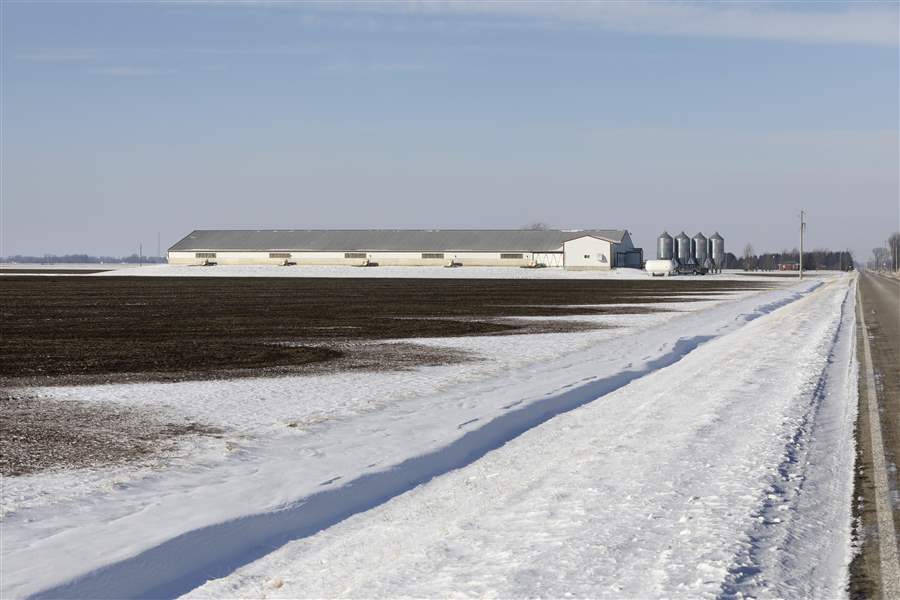
Bad actors hurting efforts to combat lake’s algae issue
9/6/2018
Early this year, manure was spread on these snow-covered fields west of Napoleon, in violation of state regulations that forbid the practice. Manure that runs off into the Maumee River and Lake Erie is understood to be a major factor in algal blooms on the lake.
THE BLADE
Buy This Image
WEST SISTER ISLAND, Ohio — Although the 2018 Lake Erie algal bloom did not develop to the degree that some experts had expected, it definitely made an appearance. The algae did not envelope the Toledo water-intake crib in Maumee Bay, and it didn’t suffocate large areas of the western end of the lake, but vast mats of the green, spongy goo did spread out across the lake north of here.
“There were blooms of 35-to-40 square miles of the stuff, and it was very heavy,” said veteran Lake Erie captain Dave Spangler, who is one of the top water quality watchdogs from the Lake Erie Charter Boat Association as its vice president.
“It started out looking like another gang-buster kind of year and the bloom started early — the earliest I had ever seen it — but then we went through a semi-drought and we didn’t get a lot more nutrients loading into the lake. It didn’t get as bad as expected, but I think we were just fortunate we went into a drought mode in mid-summer. At the pace we were going back in late June, it looked like it was going to be another nine or 10 on the scale.”
Credit the lack of rain, with a big assist from the wind, according to Travis Hartman, the Lake Erie Program Administrator for the Ohio Department of Natural Resources working out of the Sandusky Fisheries Research Station.
“In my opinion, the wind we had and the timing of the wind made a big difference,” Hartman said. “It would be hot and calm for a few days and it seemed like the algae was really getting going, and then we would get a northeast wind event and that would break it up. The way I see it, the longer it is calm, the more chance the algae has to continue to bloom.”
Walleye pro Ross Robertson, who spends the majority of his days out on the lake, said at this point on the calendar the bloom appears to be more localized, with some concentrations north of Pelee Island, but he didn’t see the scope of the bloom approach the earlier expectations.
“I certainly don't want to discount that we have some issues and the runoff into the lake, from all standpoints, isn't good,” Robertson said, highlighting the prime suspect behind the blooms — the runoff of agricultural fertilizer and manure. “But I don't think we have the red tide Florida-type deal going on.”
Hartman pointed out that the fuel to ignite and sustain an algal bloom is present. Spangler said that way too many of those nutrients that feed the algae are still getting into the lake.
“We can’t jump up and down now and say how great it looked this year,” he said. “It was better than what was originally expected, but way more than what we should have. The reality is that nothing has really changed — what feeds the bloom is still coming off the land.”
VIDEO: Captain Dave Spangler talking about Lake Erie algal bloom and its negative impact
There was evidence earlier this year from points across the Maumee River watershed that some bad actors have ignored the science, ignored the recommendations from experts, and they continue very troubling practices.
Back in January at a farm near the corner of Defiance Henry County Line Road and Youngman Road northwest of Napoleon, large quantities of manure were spread on snow-covered fields. This is one of the most harmful actions, according to the regulations outlined by the Ohio State University Extension.
A bit later in the spring, livestock on a farm in Huron County, near the intersection of Peru West Section Line Road and Hettle Road, were wallowing in deep mud and manure on a parcel that sloped right into the West Branch of the Huron River a few feet away. The waterway, still cold with the runoff of melting snow, already had a distinct green cast.
Spangler hopes to remind everyone — farmers, fishermen, landscapers, property owners, etc. — that everything ends up in the lake, eventually. He said it is a very ominous sign when his clients begin asking about how bad the algae bloom is instead of asking about how good the fishing has been.
“There is a reason why those regulations came about, and it’s not just what we do in the summer that impacts the algal bloom — it’s what happens every day of the year that matters,” he said.
“If you dump manure on frozen ground, it’s going to run into the ditch, into the river, and right into the lake. That’s what’s going to happen. And if you don’t use fertilizer in the proper manner, it’s the same thing. It all runs downhill, and it all ends up in the lake to feed the next algal bloom. That connection is pretty darn clear.”
While we did not suffer a catastrophic algal bloom such as the one that in 2014 fouled the water supply of a half million people with toxins, and with much more research and information on the subject now available so many in the agricultural community are utilizing safer practices, Spangler said the goal of a cleaner lake with significantly less algae issues is still distant.
“We’re just not going to get there without a concentrated effort from most of the fertilizer guys and the animal farmers,” he said. “Crawling is the best word — I think we are crawling in the right direction, when what we should be doing is running.”
Contact Blade outdoors editor Matt Markey at mmarkey@theblade.com or 419-724-6068.